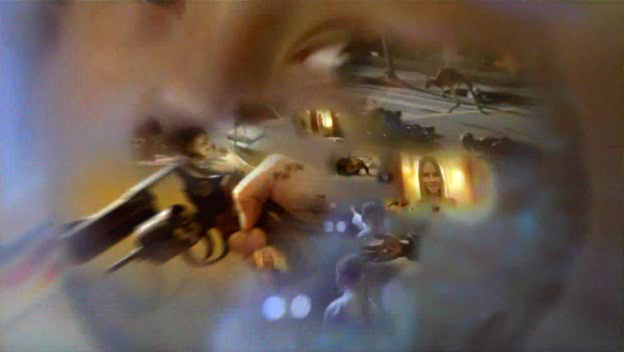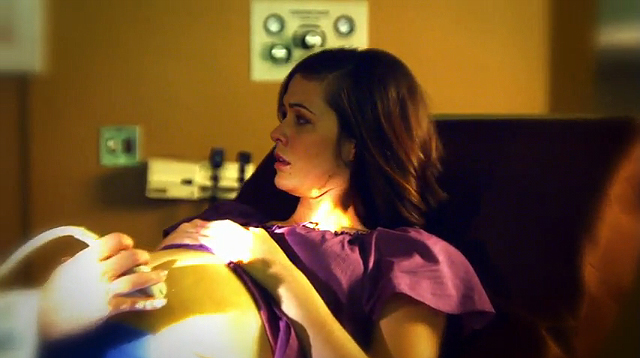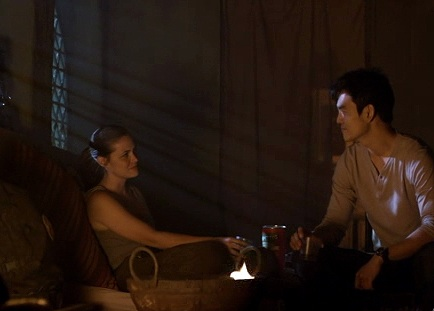“Fight for the Futures We Want”: FlashForward, Temporality and Queer Possibilities
Melanie Kohnen / Georgia Institute of Technology

What happens if cancellation ends a series in which the future is the main engine behind narrative, plot and character development? Does this abrupt ending keep the diegesis in stasis or does it allow for continuing engagement? Specifically, does cancellation enable a different understanding of the series’ ideological work? In the case of ABC’s drama FlashForward (2009-10), these questions become particularly charged due to the series’ conflicting depictions of the relationship between queerness and temporality.
In FlashForward, temporality is at the center of the narrative. As the voice-over at the beginning of every episode states, “On October 6, 2009, the planet blacked out for two minutes and seventeen seconds. The whole world saw the future.” The future in question is April 29, 2010. Over the course of the season, characters struggle with interpreting the visions of life, death, and romance in their “flash forwards.”
FlashForward‘s engagement with diegetic temporality offers contradictory ideas of the future. On the one hand, its narrative is oriented toward the events of April 29—this linear move toward a predefined ending point defies the usual open-endedness of televisual narrative. This linear unfolding of events toward a predefined ending recalls the idea of straight time: (heteronormative) life scripts move from beginning to end via a series of predefined milestones that comprise marriage and children.1 On the other hand, FlashForward‘s diegetic time is already out of synch. Its linearity is compromised because human consciousness can flash ahead to the future: as one character puts it, the flash forwards are “memories of events that haven’t occurred yet” (1×01). The characters hold on to these memories as blueprints of their future—but as is often the case with memories, they are not accurate representations of events. As the finale shows, even when characters end up exactly where they are supposed to be, small details of their futures-turned-present diverge from how they had interpreted their flash forwards (subsequently FF). In this way, FlashForward breaks with the linearity of straight time to offer moments of unknowability that challenge the script of life.

The tension between seemingly predetermined linearity and moments of uncertainty becomes pressing for one of the central characters, FBI agent Janis Hawke (Christine Woods). Janis’ arc in this season of FlashForward offers an opportunity to think about multiple ways of interpreting the place of non-straight representations in ideas of the future. Janis is among those characters who become desperate to see their FF come true: during the blackout, she sees herself undergoing a prenatal sonogram. At first, Janis perceives this FF as, in her words, “bizarre” considering that she is single and never planned on having children. A few episodes later, we find out that Janis is a lesbian, which we are supposed to understand as a further indication that her FF is unlikely to become a reality.2 Janis appears conflicted about the prospect of motherhood: when Janis’ date suggests that maybe the “baby is ours,” Janis promptly stops seeing her (1×05). Up until this point, Janis seems to affirm long-standing notions regarding queerness and reproduction, namely, that they are (or should be) mutually exclusive. The narrative strongly implies that as a lesbian, Janis has never considered having children and that she is not interested in normative family arrangements.

The turning point in Janis’ attitude toward her potential future child is her near-fatal shooting. In the moment that her future is almost denied to her, she begins to cling to one of the most naturalized ideas about the future: that children are the future. She confides in her colleague and friend Demetri Noh (John Cho) that when she was shot, “the only thing I could think about was that baby. The possibility that I wouldn’t have her.” When Demetri cautions her by saying that this baby doesn’t exist yet, she responds, “We both have to fight for the futures we want” (significantly, Demetri didn’t see anything during his FF and later learns that this means he won’t be alive on April 29, 1×13).
[youtube]http://www.youtube.com/watch?v=9fpo-99IYrI[/youtube]
Subsequently, Janis becomes obsessed with becoming pregnant in time to conceive the exact baby she saw in her FF. An unexpected work trip to Somalia seems to render this prospect impossible, but in a twist that I dreaded from the first moment in which Janis shares her FF with Demetri, Demetri offers to sleep with Janis so she can have a chance at getting pregnant at the right time. Interestingly, FlashForward avoids the most dreadful implications of this scenario. Janis neither spontaneously questions her sexual preferences nor falls for Demetri. Indeed, the dialogue in the scene reaffirms Janis lesbian identity as Demetri jokingly says that sleeping with him will only make her “gayer” (1×14). Revising the earlier implication that queerness and reproduction are irreconcilable, the overt declaration of Janis’ lesbian identity underlines that heterosexual romance is not a requirement Janis has to fulfill to lay claim to her maternal future. A few weeks later, Janis finds out that she is indeed pregnant.
Janis’ obsession with having the baby she saw during her FF seems to affirm the future as heteronormative construct that prioritizes reproduction over any other goal in life (a process that Lee Edelman and others have called the logic of reproductive futurism).3 But FlashForward also challenges the idea that the future systematically excludes anyone who strays off the heterosexual path. I see Janis’ pregnancy (and repeatedly affirmed lesbian identity) as representative of the recent inclusion of (white, upwardly mobile/economically stable) gays and lesbians into life (and the reproduction of life), whereas previously they were connected with death.4 While one might consider this a welcome diversification, it comes at a price. This vision of the future is perhaps even more unsettling than complete exclusion as it drives ever-finer lines between who can and cannot be part of (televisual) life.

In the case of FlashForward, the ultimate consequence of Demetri and Janis’ encounter is the excision of Demetri’s fiancee Zoe Andata (Gabrielle Union) from the narrative. Zoe leaves Demetri after finding out that for him, fighting for the future of Janis’ baby was more important than fighting for his own future (which would have included getting married to Zoe). Zoe does not appear in the remaining episodes. While there is room in FlashForward‘s future for a white lesbian mother, there is none for the woman of color. There is also no room for an alternative family arrangement comprising Janis, Demetri and Zoe, a suggestion of Demetri’s that Janis categorically rejects. By claiming the baby as exclusively hers, Janis effectively whitewashes her child.
While the vision of the future that Janis’ storyline paints is quite sinister, it never materializes.5ABC canceled FlashForward on May 20, 2010. FlashForward literally has no future. Yet, the program gestures beyond its cancellation by ending its final episode on another flash forward. This flash forward does not leave us with a fully-formed image of the future, however; we only catch hazy glimpses. Those glimpses form an assemblage of possibilities that exceeds narrative cohesion.6 We simply do not know what this future means. All that remains are gestures toward a future.
If FlashForward holds any queer possibilities, they cannot be found in its narrative, but in the ways in which the program fits into the temporality of television itself: FlashForward gestures toward a future that we will never see and that has been effectively denied. José Muñoz finds that the gesture holds some queerly utopian potential—a “not-quite-there.”7 Since FlashForward will not be narrated for us by writers and producers, are we able to picture a future that is much queerer than FlashForward‘s final glimpses suggest?
Image Credits:
1. Author’s screen grab.
2. Author’s screen grab.
3. Author’s screen grab.
4. Author’s screen grab.
- Halberstam, Judith. In a Queer Time and Place: Transgender Bodies, Subcultural Lives. New York: NYU Press, 2005. [↩]
- Video at http://www.youtube.com/user/hilo2308#p/u/23/A-ayQfoNBEk [↩]
- Edelman, Lee. No Future: Queer Theory and the Death Drive. Durham and London: Duke University Press, 2004. [↩]
- Puar, Jasbir K. Terrorist Assemblages: Homonationalism in Queer Times. Durham and London: Duke University Press, 2007. [↩]
- Another aspect of Janis’ storyline that doesn’t fully materialize is the mid-season suggestion that Janis might be a villain, after all, and working against the FBI. A few episodes later, she is recuperated as double-agent. Nevertheless, FlashForward‘s flirtation with the trope of the “evil lesbian” deserves attention, but goes beyond the scope of this article. [↩]
- My use of assemblage is inspired by Jasbir Puar, especially her ideas in the following passage: “For while intersectionality and its underpinnings—an unrelenting epistemological will to truth—presupposes identity and thus disavows futurity, or, perhaps more accurately, prematurely anticipates and thus fixes a permanence to forever, assemblage, in its debt to ontology and its espousal of what cannot be known, seen, or heard, or has yet to be known, see, or heard, allows for becoming beyond or without being” (Terrorist Assemblages, 216). [↩]
- José Esteban Muñoz. “Crusing the Toilet: LeRoi Jones/Amiri Baraka, Radical Black Traditions, and Queer Futurity.” GLQ 13.2-3 (2007) 353-367. [↩]
I like your discussion of Janice’s reproductive future. Do you think that this scenario seeks to contain alternate sexuality as a non-fluid, non-threatening manner? I’m thinking of Demetri making Janice “gayer.”
Caroline,
Thank you for your comment! Yes, I definitely agree that the repeated emphasis on Janis’ lesbian identity helps to set her apart from the straight characters on FlashForward so that there is no room for ambiguity about characters’ sexual identities left. Interestingly enough, in Janis’ character profile on ABC’s official youtube channel, there is no mentioning of her being a lesbian. Based on the selection of clips for the profile, It would actually be very easy to assume that she’s straight. It’s a curious contrast to the show itself.